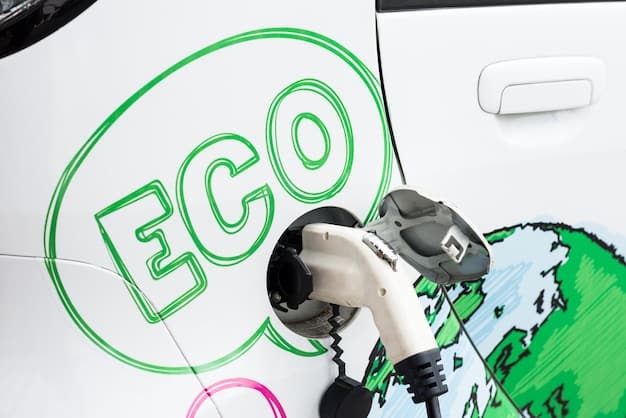Fact-Checking: Will All Cars Need to Be Electric by 2035?

Claims about a federal law mandating all cars to be electric by 2035 are largely inaccurate; while the EPA has proposed stricter emissions standards to encourage EV adoption, no law mandates a complete transition to electric vehicles nationwide by that year.
The buzz around electric vehicles (EVs) is undeniable, and so are the rumors. Let’s fact-check the claims about a new federal law requiring all cars to be electric by 2035. Is this truly on the horizon, or is it just another piece of misinformation gaining traction? We’ll unpack the truth behind the headlines, providing clarity and debunking myths surrounding the future of automotive transportation in the US.
Fact-Checking the Electric Vehicle Mandate: Separating Truth from Fiction
Recent discussions and media coverage have sparked intense debate over the future of cars in America. Central to this discussion is the claim that a new federal law mandates all vehicles sold by 2035 to be electric. Understanding the reality requires a closer look at existing policies and proposed regulations. This section aims to clarify the details and debunk popular misconceptions.
Understanding the EPA’s Role
The Environmental Protection Agency (EPA) plays a vital role in regulating vehicle emissions. The EPA has proposed new emissions standards aimed at significantly reducing pollution from the transportation sector. These standards are designed to encourage, but not mandate, the transition to electric vehicles.
These standards fall under the Clean Air Act, giving the EPA the authority to regulate pollutants emitted by vehicles. The proposed regulations set increasingly stringent emissions limits, incentivizing manufacturers to produce more electric vehicles to meet these requirements.

Here are several key aspects of the proposed EPA regulations:
- Stricter Emission Standards: The proposal aims to reduce greenhouse gas emissions from vehicles substantially over the next decade.
- Incentivizing EV Production: By setting tougher standards, the EPA hopes to encourage automakers to increase their production and sales of electric vehicles.
- Flexibility for Manufacturers: The regulations are designed to provide flexibility for manufacturers to meet the new standards using various technologies, including EVs, hybrids, and fuel-efficient gasoline vehicles.
In conclusion, while the EPA’s proposed regulations strongly encourage the adoption of electric vehicles, they do not mandate a complete transition to EVs by 2035. The focus is on reducing emissions, and manufacturers have options for achieving these reductions.
Analyzing the Proposed Regulations: What They Really Say
The core of the debate lies in interpreting the proposed regulations. It’s essential to sift through the details to understand their true implications. This section will break down the key components of the regulations and analyze their potential impact on the automotive industry and consumers.
While the EPA’s proposal sets ambitious goals for emissions reductions, it allows automakers flexibility in how they meet these targets. This flexibility is a critical aspect, as it acknowledges the diverse needs and capabilities of different manufacturers.
Key Provisions of the Proposed Regulations
The proposed regulations include several important provisions. These provisions outline the specific emissions standards that manufacturers must meet, as well as the mechanisms for enforcing these standards.
One important aspect is the averaging, banking, and trading (ABT) program, which allows manufacturers to earn credits for producing vehicles with lower emissions than required. These credits can be used to offset emissions from vehicles that exceed the standards.

Exploring the intricacies behind the regulations, here are some specifics:
- Phased Implementation: The regulations are intended to be gradually phased in over several years, allowing automakers time to adjust their production strategies.
- Technology Neutrality: The EPA emphasizes that the regulations are technology-neutral, meaning that manufacturers can use various technologies to meet the emissions standards.
- Consumer Choice: The EPA acknowledges the importance of consumer choice and aims to ensure that a variety of vehicle options remain available to consumers.
In summary, the proposed regulations are complex and multifaceted. They aim to drive down emissions while providing manufacturers with the flexibility they need to innovate and adapt. It’s true that consumer preferences will ultimately shape the pace of the transition to electric vehicles, irrespective of regulatory pressure.
State-Level Initiatives: California’s Role and Influence
California has often been at the forefront of environmental regulations, setting trends that other states often follow. Understanding California’s policies is crucial in assessing the broader landscape of electric vehicle adoption in the United States. This section examines California’s initiatives and their potential impact nationwide.
California’s Advanced Clean Cars program is a prime example of state-level action. This program, which includes the Zero-Emission Vehicle (ZEV) mandate, requires automakers to sell a certain percentage of zero-emission vehicles in the state. The ZEV mandate is designed to accelerate the adoption of electric vehicles by ensuring that they are more widely available to consumers.
California’s ZEV Mandate
The ZEV mandate has significantly influenced the electric vehicle market. By requiring automakers to sell a certain number of ZEVs, it has encouraged them to invest in electric vehicle technology and infrastructure.
Several other states have adopted California’s ZEV standards, further amplifying their impact. These states, often referred to as “Section 177 states,” are allowed under the Clean Air Act to adopt California’s more stringent emissions standards.
- Market Impact: The ZEV mandate has led to increased availability of electric vehicles in participating states, driving down prices and increasing consumer adoption.
- Technological Innovation: The mandate has spurred innovation in electric vehicle technology, as automakers compete to develop more efficient and affordable EVs.
- National Influence: California’s policies often serve as a model for federal regulations, shaping the national conversation around environmental issues.
In conclusion, California’s initiatives, particularly the ZEV mandate, have played a key role in promoting electric vehicle adoption. While these initiatives are not federal law, they exert considerable influence on the automotive industry and the broader transition to electric vehicles.
Consumer Perspectives: Affordability, Infrastructure, and Concerns
The success of any transition to electric vehicles hinges on consumer acceptance. Understanding consumers’ perspectives, including their concerns about affordability, infrastructure, and performance, is crucial. This section explores these issues and their potential impact on the adoption of electric vehicles.
Affordability remains a significant barrier for many consumers. Electric vehicles often have a higher upfront cost than gasoline-powered cars, even though they may offer long-term savings through lower fuel and maintenance costs. Government incentives, such as tax credits and rebates, can help offset this upfront cost.
Addressing Consumer Concerns
Beyond affordability, consumers also have concerns about the availability of charging infrastructure. Many potential EV buyers worry about whether they will be able to find convenient and reliable charging stations, particularly on long trips.
Range anxiety, the fear of running out of battery power, is another common concern. While electric vehicle ranges have improved significantly in recent years, many consumers still worry about whether an EV can meet their daily driving needs.
- Incentives and Rebates: Government programs can significantly reduce the upfront cost of EVs, making them more accessible to a broader range of consumers.
- Infrastructure Development: Investing in public charging infrastructure is essential to alleviating range anxiety and encouraging EV adoption.
- Education and Awareness: Educating consumers about the benefits and capabilities of EVs can help overcome misconceptions and promote informed decision-making.
In summary, addressing consumer concerns about affordability, infrastructure, and performance is essential for accelerating the adoption of electric vehicles. Government policies, industry initiatives, and consumer education all have a role to play in overcoming these barriers.
Industry Adaptations: Automakers’ Strategies and Investments
The automotive industry is undergoing a significant transformation as automakers adapt to the changing landscape. Understanding automakers’ strategies and investments in electric vehicles is crucial for assessing the feasibility of a broader transition to EVs. This section examines these strategies and their potential impact on the market.
Many major automakers have announced ambitious plans to electrify their fleets. These plans involve significant investments in electric vehicle technology, battery production, and charging infrastructure. Automakers recognize that electric vehicles are the future of transportation, and they are positioning themselves to compete in this emerging market.
Automakers’ Electrification Plans
Automakers are pursuing various strategies to electrify their fleets. Some are focusing on developing entirely new electric vehicle platforms, while others are adapting existing platforms to accommodate electric powertrains.
Collaboration is also playing a key role, with automakers partnering with battery manufacturers and technology companies to accelerate electric vehicle development. These partnerships allow automakers to leverage expertise and resources from other industries.
- Platform Development: Investing in dedicated electric vehicle platforms allows automakers to optimize the design and performance of their EVs.
- Battery Technology: Advances in battery technology are driving down costs and improving the range and performance of electric vehicles.
- Strategic Partnerships: Collaborating with other companies allows automakers to share risks and accelerate innovation in electric vehicle technology.
In conclusion, the automotive industry is making significant investments in electric vehicles, signaling a long-term commitment to electrification. These investments are driving innovation and helping to make electric vehicles more affordable and accessible to consumers.
Policy and Politics: The Role of Government in EV Adoption
Government policies play a crucial role in shaping the adoption of electric vehicles. Understanding the various policy levers that governments can use to promote EVs is essential for predicting the future of the automotive industry. Explore the influence of government in the adoption of EVs in this section.
Governments can use a variety of policies to encourage the adoption of electric vehicles, including tax credits, rebates, emissions regulations, and infrastructure investments. These policies can help lower the cost of EVs, improve charging infrastructure, and create a more favorable regulatory environment for electric vehicles.
Government Policies Promoting EVs
Tax credits and rebates are among the most effective policies for promoting EV adoption. These incentives can significantly reduce the upfront cost of EVs, making them more attractive to consumers.
Emissions regulations, such as the EPA’s proposed standards, can also play a key role by incentivizing automakers to produce more electric vehicles. Infrastructure investments, such as building public charging stations, can help alleviate range anxiety and make EVs more convenient to use.
- Financial Incentives: Tax credits and rebates can lower the cost of EVs, increasing affordability and driving adoption.
- Regulatory Standards: Emissions regulations can push automakers to produce more EVs, accelerating the transition to electrification.
- Infrastructure Investment: Government support for charging infrastructure can alleviate range anxiety and make EVs more practical for everyday use.
In summary, government policies are a critical driver of electric vehicle adoption. By using a combination of financial incentives, regulatory standards, and infrastructure investments, governments can create a supportive ecosystem for electric vehicles and accelerate the transition to a cleaner transportation future.
| Key Point | Brief Description |
|---|---|
| 🏛️ EPA Regulations | Proposed stricter emissions standards to encourage EV adoption but no outright mandate. |
| ⚡ ZEV Mandate | California’s policy requiring automakers to sell a percentage of zero-emission vehicles. |
| 💰 Consumer Concerns | Affordability, charging infrastructure, and range anxiety are key factors affecting adoption. |
| 🚗 Industry Investments | Automakers investing in EV tech, battery production, and infrastructure. |
Frequently Asked Questions (FAQ)
▼
No, there is no such federal law. The EPA has proposed stricter emissions standards, but these do not mandate a complete transition to EVs.
▼
The EPA sets emissions standards for vehicles. Stricter standards incentivize automakers to produce more EVs, though they don’t require it.
▼
California’s ZEV mandate requires automakers to sell a certain percentage of zero-emission vehicles in the state.
▼
Consumer concerns include the higher upfront cost, availability of charging infrastructure, and range anxiety.
▼
Automakers are investing heavily in EV technology, battery production, and strategic partnerships to accelerate the EV transition.
Conclusion
While there isn’t a federal law mandating all cars to be electric by 2035, the automotive industry is undoubtedly shifting towards electrification. Proposed regulations and consumer demand make it the way forward. The future promises a blend of traditional vehicles and EVs, coexisting. So, no need to scrap that gasoline-powered car just yet!





